You are using an out of date browser. It may not display this or other websites correctly.
You should upgrade or use an alternative browser.
You should upgrade or use an alternative browser.
Photos Navies Of All Nations
- Thread starter BravoZulu
- Start date
-
- Tags
- hms saumarez
- Joined
- Apr 2, 2017
- Messages
- 38,640
- Points
- 463
Denmark:
June 11, 2003: Sælen S-323 at Manama, Bahrain being loaded on to the German heavy lift ship Grietje for return to her homeport Fredrikshavn, Denmark after a 385 day deployment in the Mediterranean Sea and the Persian Gulf supporting Operation Iraqi Freedom.
June 11, 2003: Sælen S-323 at Manama, Bahrain being loaded on to the German heavy lift ship Grietje for return to her homeport Fredrikshavn, Denmark after a 385 day deployment in the Mediterranean Sea and the Persian Gulf supporting Operation Iraqi Freedom.

- Joined
- Apr 2, 2017
- Messages
- 38,640
- Points
- 463
Germany:
The sinking of battleship Bismarck as seen from HMS Dorsetshire. This picture was taken by Petty Officer L.H. Martin.
KMS Scharnhorst conducts a torpedo firing drill in the Baltic after her refit

Kommandant and Watch Officer confer in a lighter moment on the conning tower of a Type VIIC
U-135 with Captain Praetorius wearing the white cap.
For her last patrol, she left Lorient on 7 June 1943. Northeast of the West Indies, she attacked and damaged Twickenham on the 15th. She then moved to the east Atlantic where she was attacked by the sloop HMS Rochester, the corvettes HMS Migonette and Balsam and a US PBY Catalina flying boat of VP-92. U-135 was sunk east of the Canary Islands on 15 July. Five men died, there were 41 survivors.
The sinking of battleship Bismarck as seen from HMS Dorsetshire. This picture was taken by Petty Officer L.H. Martin.

KMS Scharnhorst conducts a torpedo firing drill in the Baltic after her refit

Kommandant and Watch Officer confer in a lighter moment on the conning tower of a Type VIIC

U-135 with Captain Praetorius wearing the white cap.
For her last patrol, she left Lorient on 7 June 1943. Northeast of the West Indies, she attacked and damaged Twickenham on the 15th. She then moved to the east Atlantic where she was attacked by the sloop HMS Rochester, the corvettes HMS Migonette and Balsam and a US PBY Catalina flying boat of VP-92. U-135 was sunk east of the Canary Islands on 15 July. Five men died, there were 41 survivors.
- Joined
- Apr 2, 2017
- Messages
- 38,640
- Points
- 463
RN:
HMS Royal Oak at full speed, showing guns at full elevation, WW1

HMS Queen Mary explodes during the Battle of Jutland, May 31, 1916

She was hit twice by the German battlecruiser Derfflinger during the early part of the battle and her magazines exploded shortly afterwards, sinking the ship.
One shell hit forward and detonated one or both of the forward magazines, which broke the ship in two near the foremast. Stationed inside 'Q' turret, Midshipman Jocelyn Latham Storey survived and reported that there had been a large explosion forward which rocked the turret, breaking the left gun in half, the gun breech falling into the working chamber and the right gun coming off its trunnions. Cordite in the working chamber caught fire and produced poisonous fumes that asphyxiated some of the turret's crew. It is doubtful that an explosion forward could have done this, so 'Q' turret may have been struck by the second shell. A further explosion, possibly from shells breaking loose, shook the aft end of the ship as it began to roll over and sink. Tiger, the battlecruiser behind her, was showered with debris from the explosion and forced to steer to port to avoid her remains. 1,266 crewmen were lost; eighteen survivors were picked up by the destroyers Laurel, Petard, and Tipperary, and two by the Germans.
Queen Mary, along with the other Jutland wrecks, has been declared a protected place under the Protection of Military Remains Act 1986 to discourage further damage to the resting place of 1,266 officers and men. Surveys of this site conducted by nautical archaeologist Innes McCartney in 2001–03 have shown the wreck is in three sections, with the two forward sections being heavily damaged and in pieces. Her aft end is upside down and relatively complete except for her propellers, which have been salvaged. Examination of the damage to the ship has suggested that the initial explosion was not in the magazine of 'A' or 'B' forward main turrets, but instead in the magazine of the forward 4-inch battery. An explosion of the quantity of cordite in the main magazine would have been sufficient to also ignite 'Q' magazine, destroying much more of the ship. The explosion in the smaller magazine would have been sufficient to break the ship in two, the blast then spreading to the forward magazine and ripping apart the forward section
HMS Royal Oak at full speed, showing guns at full elevation, WW1

HMS Queen Mary explodes during the Battle of Jutland, May 31, 1916

She was hit twice by the German battlecruiser Derfflinger during the early part of the battle and her magazines exploded shortly afterwards, sinking the ship.
One shell hit forward and detonated one or both of the forward magazines, which broke the ship in two near the foremast. Stationed inside 'Q' turret, Midshipman Jocelyn Latham Storey survived and reported that there had been a large explosion forward which rocked the turret, breaking the left gun in half, the gun breech falling into the working chamber and the right gun coming off its trunnions. Cordite in the working chamber caught fire and produced poisonous fumes that asphyxiated some of the turret's crew. It is doubtful that an explosion forward could have done this, so 'Q' turret may have been struck by the second shell. A further explosion, possibly from shells breaking loose, shook the aft end of the ship as it began to roll over and sink. Tiger, the battlecruiser behind her, was showered with debris from the explosion and forced to steer to port to avoid her remains. 1,266 crewmen were lost; eighteen survivors were picked up by the destroyers Laurel, Petard, and Tipperary, and two by the Germans.
Queen Mary, along with the other Jutland wrecks, has been declared a protected place under the Protection of Military Remains Act 1986 to discourage further damage to the resting place of 1,266 officers and men. Surveys of this site conducted by nautical archaeologist Innes McCartney in 2001–03 have shown the wreck is in three sections, with the two forward sections being heavily damaged and in pieces. Her aft end is upside down and relatively complete except for her propellers, which have been salvaged. Examination of the damage to the ship has suggested that the initial explosion was not in the magazine of 'A' or 'B' forward main turrets, but instead in the magazine of the forward 4-inch battery. An explosion of the quantity of cordite in the main magazine would have been sufficient to also ignite 'Q' magazine, destroying much more of the ship. The explosion in the smaller magazine would have been sufficient to break the ship in two, the blast then spreading to the forward magazine and ripping apart the forward section
- Joined
- Apr 2, 2017
- Messages
- 38,640
- Points
- 463
Greece:
A Greek navy minesweeper and a Portuguese-flagged cargo ship collided Tuesday outside the country’s main port of Piraeus, leaving two navy crew slightly injured and prompting the evacuation of the military vessel.
It was not immediately clear why the minesweeper and the cargo ship, the Maersk Launceston container vessel, collided. The coast guard said all 27 navy crew members were rescued from the minesweeper, which sustained damage.
The two injured crew members were transported to a hospital, while the rest were transferred to another navy vessel, the coast guard said.
Hunt-class Mine Countermeasure Vessel HS Kallisto (ex HMS Berkeley) split in two after collision
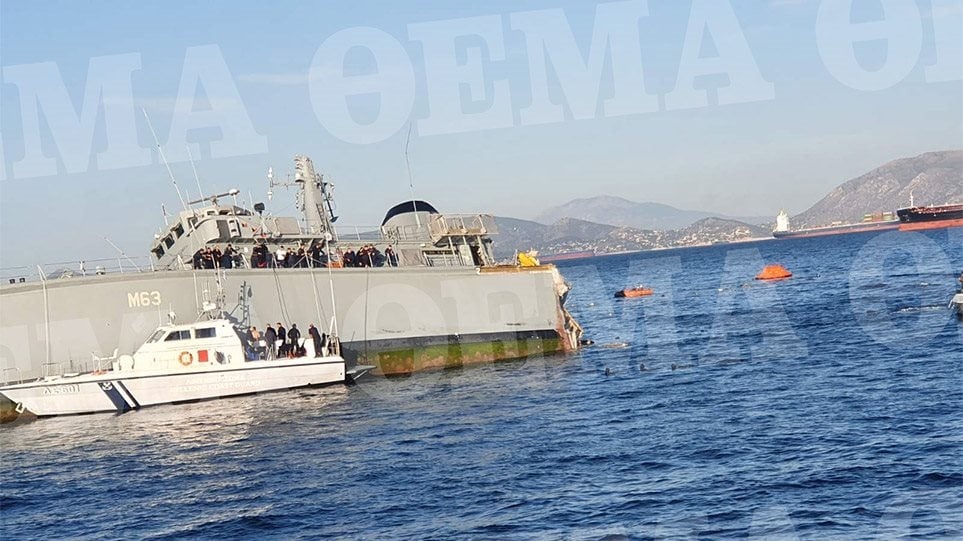
A Greek navy minesweeper and a Portuguese-flagged cargo ship collided Tuesday outside the country’s main port of Piraeus, leaving two navy crew slightly injured and prompting the evacuation of the military vessel.
It was not immediately clear why the minesweeper and the cargo ship, the Maersk Launceston container vessel, collided. The coast guard said all 27 navy crew members were rescued from the minesweeper, which sustained damage.
The two injured crew members were transported to a hospital, while the rest were transferred to another navy vessel, the coast guard said.
Hunt-class Mine Countermeasure Vessel HS Kallisto (ex HMS Berkeley) split in two after collision

- Joined
- Apr 2, 2017
- Messages
- 38,640
- Points
- 463
Italy:
Recon photo of the harbour of Naples, likely in December 1940; the battleships Vittorio Veneto and Giulio Cesare can be seen moored at the pier
Light cruiser Ottaviano Augusto shortly before her launch, Ancona, 31 May 1942
The Capitani Romani-class "light cruiser" Ottaviano Augusto was built by the Cantieri Navali Riuniti of Ancona; however, by 8 September 1943 the ship was still incomplete, therefore she was captured by German troops and abandoned in port. She would be sunk during an Allied air raid on 1 November 1943, and her wreck would be raised and scrapped after the war.
Recon photo of the harbour of Naples, likely in December 1940; the battleships Vittorio Veneto and Giulio Cesare can be seen moored at the pier

Light cruiser Ottaviano Augusto shortly before her launch, Ancona, 31 May 1942

The Capitani Romani-class "light cruiser" Ottaviano Augusto was built by the Cantieri Navali Riuniti of Ancona; however, by 8 September 1943 the ship was still incomplete, therefore she was captured by German troops and abandoned in port. She would be sunk during an Allied air raid on 1 November 1943, and her wreck would be raised and scrapped after the war.
- Joined
- Apr 2, 2017
- Messages
- 38,640
- Points
- 463
USN:
USS Shangri-La (CVA-38), foreground, and USS Enterprise (CVAN-65) at Souda Bay, Crete (Greece), on 28 February 1964.
Shangri-La, with assigned Attack Carrier Air Wing 10 (CVW-10), was deployed to the Mediterranean Sea from 1 October 1963 to 23 May 1964.
Enterprise, with assigned CVW-6, was on her world cruise ("Operation Sea Orbit") from 8 February to 3 October 1964.
USS Shangri-La (CVA-38), foreground, and USS Enterprise (CVAN-65) at Souda Bay, Crete (Greece), on 28 February 1964.
Shangri-La, with assigned Attack Carrier Air Wing 10 (CVW-10), was deployed to the Mediterranean Sea from 1 October 1963 to 23 May 1964.
Enterprise, with assigned CVW-6, was on her world cruise ("Operation Sea Orbit") from 8 February to 3 October 1964.

- Joined
- Apr 2, 2017
- Messages
- 38,640
- Points
- 463
RN:
HMS Albion, this photo was taken just before exercise Joint Warrior 19, with her well deck flooded about to receive a Landing Craft (Utility), just before coming alongside in Faslane.

HMS Diamond leaving Plymouth to continue with her Operational Sea Training, Oct 26th

HMS Tyne arriving for visit to the Tyne today.

HMS Richmond seen anchored in Tor Bay this afternoon

HMS Kent outbound from Faslane this morning

HMS Albion, this photo was taken just before exercise Joint Warrior 19, with her well deck flooded about to receive a Landing Craft (Utility), just before coming alongside in Faslane.

HMS Diamond leaving Plymouth to continue with her Operational Sea Training, Oct 26th

HMS Tyne arriving for visit to the Tyne today.

HMS Richmond seen anchored in Tor Bay this afternoon

HMS Kent outbound from Faslane this morning

- Joined
- Apr 2, 2017
- Messages
- 38,640
- Points
- 463
USN:
January 31, 2003: USS Carl Vinson CVN-70 arriving at Pearl Harbor, Hawaii for a port visit. USS Missouri BB-63 and the USS Arizona Memorial are seen in the foreground
F-35 Lightning II Carrier Variant attached to the F-35 Pax River Integrated Test Force assigned to Air Test and Evaluation Squadron 23 completes a flyover of the guided-missile destroyer USS Zumwalt in the Chesapeake Bay on Oct. 17, 2016.

USNS Medgar Evers inbound to Devonport, UK, today. Oct 26th 2020

January 31, 2003: USS Carl Vinson CVN-70 arriving at Pearl Harbor, Hawaii for a port visit. USS Missouri BB-63 and the USS Arizona Memorial are seen in the foreground

F-35 Lightning II Carrier Variant attached to the F-35 Pax River Integrated Test Force assigned to Air Test and Evaluation Squadron 23 completes a flyover of the guided-missile destroyer USS Zumwalt in the Chesapeake Bay on Oct. 17, 2016.

USNS Medgar Evers inbound to Devonport, UK, today. Oct 26th 2020

- Joined
- Apr 2, 2017
- Messages
- 38,640
- Points
- 463
USN:
The lead boat of the Balao-class submarines, USS Balao.

USS Ranger replenishes from USS Housatonic, July 17 1942

LSM-156 (Landing Ship Medium) underway near the Port of Charleston, South Carolina, June-August 1944.

USS Topeka (CL-67) at anchor in 1945, showing the classic Cleveland class profile. She is painted in Camouflage Measure 21.

USS Saint Paul (CA-73) underway in Massachusetts Bay, 15 March 1945

The lead boat of the Balao-class submarines, USS Balao.

USS Ranger replenishes from USS Housatonic, July 17 1942

LSM-156 (Landing Ship Medium) underway near the Port of Charleston, South Carolina, June-August 1944.

USS Topeka (CL-67) at anchor in 1945, showing the classic Cleveland class profile. She is painted in Camouflage Measure 21.

USS Saint Paul (CA-73) underway in Massachusetts Bay, 15 March 1945

- Joined
- Apr 2, 2017
- Messages
- 38,640
- Points
- 463
USN, Japan & Canada:
U.S. Indo-Pacific Command forces and units from the Japan Self-Defense Force began exercise Keen Sword 21 (KS21), Oct. 26, 2020, on military installations throughout mainland Japan, Okinawa prefecture, and their surrounding territorial waters.
U.S. Navy ships assigned to Ronald Reagan Carrier Strike Group join ships of Japan Maritime Self-Defense Force (JMSDF) Escort Flotilla 1, Escort Flotilla 4, and the Royal Canadian Navy, in formation during Keen Sword 21. Keen Sword is an example of the strength of U.S.-Japan Alliance, the foundation of peace and security in the Indo-Pacific region for almost 60 years. The relationships built and maintained during these events are critical to our shared capability to respond to contingencies at a moment’s notice. (Photo by Petty Officer 2nd Class Erica Bechard)
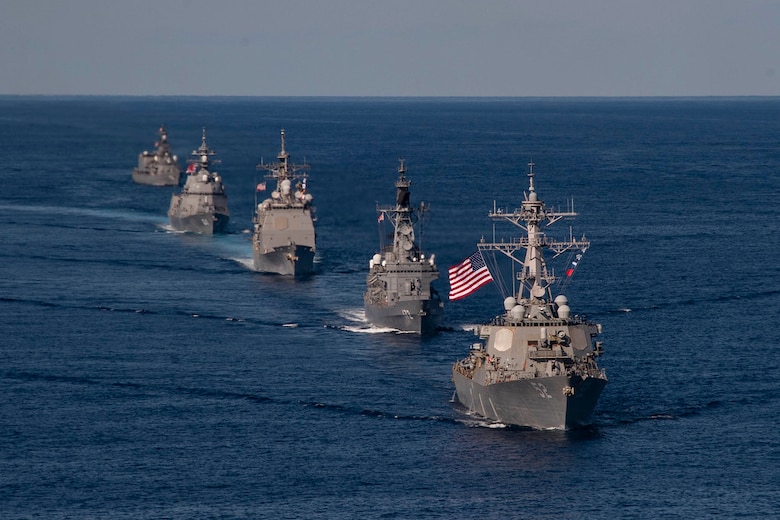
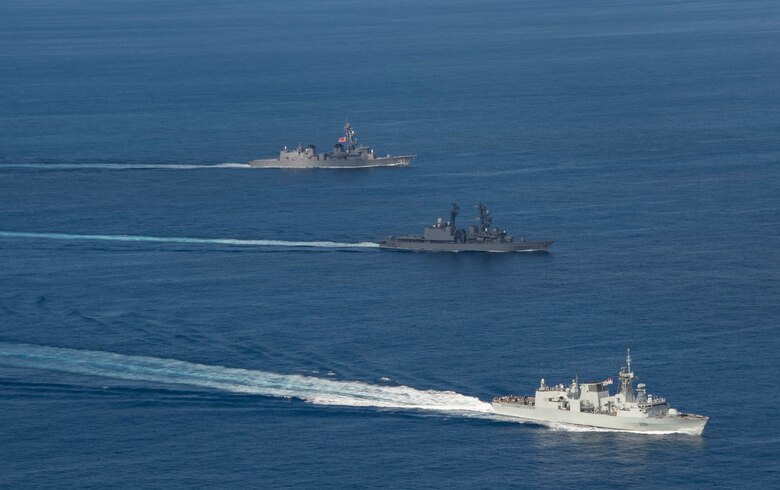
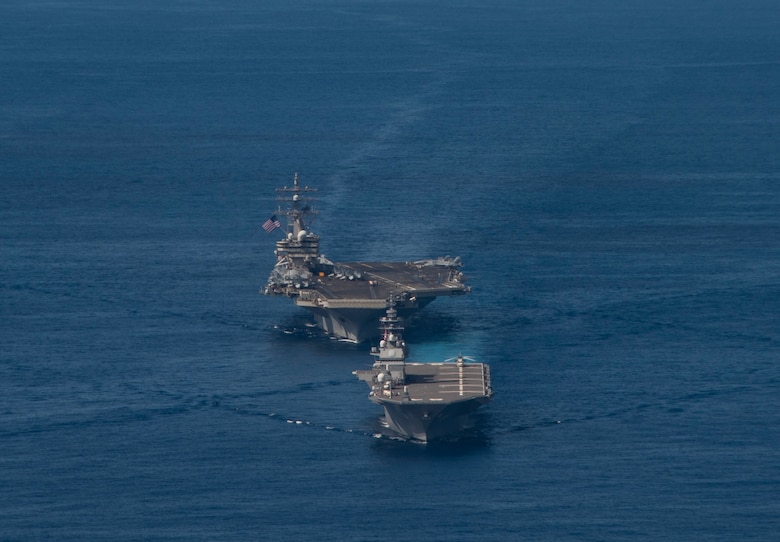
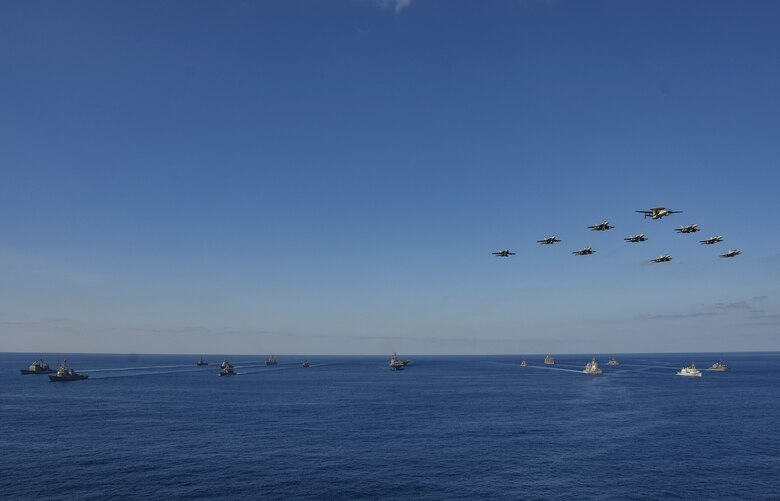
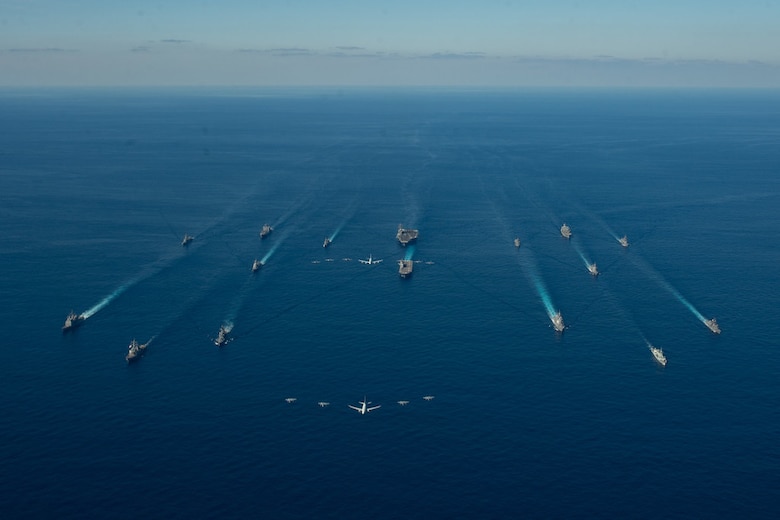
U.S. Indo-Pacific Command forces and units from the Japan Self-Defense Force began exercise Keen Sword 21 (KS21), Oct. 26, 2020, on military installations throughout mainland Japan, Okinawa prefecture, and their surrounding territorial waters.
U.S. Navy ships assigned to Ronald Reagan Carrier Strike Group join ships of Japan Maritime Self-Defense Force (JMSDF) Escort Flotilla 1, Escort Flotilla 4, and the Royal Canadian Navy, in formation during Keen Sword 21. Keen Sword is an example of the strength of U.S.-Japan Alliance, the foundation of peace and security in the Indo-Pacific region for almost 60 years. The relationships built and maintained during these events are critical to our shared capability to respond to contingencies at a moment’s notice. (Photo by Petty Officer 2nd Class Erica Bechard)






- Joined
- Apr 2, 2017
- Messages
- 38,640
- Points
- 463
RN:
HMS Cattistock arrived in Faslane yesterday

HMS Sutherland arrives the the de-ammunition buoy in the river Tamar this morning.

HMS Severn off Torquay 26th Oct 2020

HMS Enterprise heading out from Portsmouth this grey morning 24th Oct 2020

HMS Cattistock arrived in Faslane yesterday

HMS Sutherland arrives the the de-ammunition buoy in the river Tamar this morning.

HMS Severn off Torquay 26th Oct 2020

HMS Enterprise heading out from Portsmouth this grey morning 24th Oct 2020

- Joined
- Apr 2, 2017
- Messages
- 38,640
- Points
- 463
France:
Damage suffered by battleship Dunkerque, after 44 depth-charges on a patrol boat moored alongside had been detonated by a British aerial torpedo, Mers-el-Kébir, on 6 July 1940.
The detonation of the forty-four depth charges carried by the auxiliary patrol boat Terre-Neuve was equivalent to that of 1400 kg (3086 pounds) of TNT.

Damage suffered by battleship Dunkerque, after 44 depth-charges on a patrol boat moored alongside had been detonated by a British aerial torpedo, Mers-el-Kébir, on 6 July 1940.
The detonation of the forty-four depth charges carried by the auxiliary patrol boat Terre-Neuve was equivalent to that of 1400 kg (3086 pounds) of TNT.

- Joined
- Apr 2, 2017
- Messages
- 38,640
- Points
- 463
RN:
Corsair Mk I lands on HMS Victorious after a raid on Sigli, Sumatra, September 18 1944

While making an emergency landing on board HMS VICTORIOUS, a Chance-Vought Corsair's auxiliary petrol tank became detached and burst into flames, setting fire to the undercarriage during the carrier-borne air attack against the Japanese repair and maintenance centre at Sigli, Sumatra.
Corsair Mk I lands on HMS Victorious after a raid on Sigli, Sumatra, September 18 1944

While making an emergency landing on board HMS VICTORIOUS, a Chance-Vought Corsair's auxiliary petrol tank became detached and burst into flames, setting fire to the undercarriage during the carrier-borne air attack against the Japanese repair and maintenance centre at Sigli, Sumatra.
- Joined
- Apr 2, 2017
- Messages
- 38,640
- Points
- 463
RN:
Battleship HMS Audacious. Date not recorded, but must be some time between 1913 and 1914.

HMS Audacious was the fourth and last King George V-class dreadnought battleship built for the Royal Navy in the early 1910s. After completion in 1913, she spent her brief career assigned to the Home and Grand Fleets. The ship was sunk by a German naval mine off the northern coast of County Donegal, Ireland, early during the First World War. Audacious slowly flooded and finally sank after the British were unable to tow her to shore, which allowed all of her crew to be rescued. However, a petty officer on a nearby cruiser was killed by shrapnel when Audacious subsequently exploded. Even though American tourists aboard one of the rescuing ships photographed and filmed the sinking battleship, the Admiralty embargoed news of her loss in Britain to prevent the Germans from taking advantage of the weakened Grand Fleet.
Repeated reports of submarines in Scapa Flow led Jellicoe to conclude that the defences there were inadequate and he ordered that the Grand Fleet be dispersed to other bases until the defences were reinforced. On 16 October, the 2nd Battle Squadron was sent to Loch na Keal on the western coast of Scotland. The squadron departed for gunnery practice off Tory Island, Ireland, on the morning of 27 October and Audacious struck a mine at 08:45, laid a few days earlier by the German auxiliary minelayer SS Berlin. Captain Cecil Dampier, thinking that his ship had been torpedoed, hoisted the submarine warning; in accordance with instructions the other dreadnoughts departed the area, leaving the smaller ships behind to render assistance
The explosion occurred 16 feet (4.9 m) under the bottom of the ship, approximately 10 feet (3 m) forward of the transverse bulkhead at the rear of the port engine room. The engine room and the outer compartments adjacent to it flooded immediately, with water spreading more slowly to the central engine room and adjoining spaces. The ship rapidly took on a list to port of up to 15 degrees, which was reduced by counter-flooding compartments on the starboard side, so that by 09:45, the list ranged up to only nine degrees as she rolled in the heavy swell. The light cruiser Liverpool stood by, while Jellicoe ordered every available destroyer and tug out to assist, but did not send out any battleships to tow Audacious because of the supposed submarine threat. Having intercepted the stricken dreadnought's distress calls, the White Star ocean liner RMS Olympic, arrived on the scene.
The ship could make 9 knots (17 km/h; 10 mph) and Dampier believed that he had a chance of making the 25 miles (40 km) to land and beaching the ship, so he turned Audacious south and made for Lough Swilly. The ship had covered 15 miles (24 km) when the rising water forced the abandonment of the centre and starboard engine rooms and she drifted to a stop at 10:50. Dampier ordered all non-essential crew to be taken off, boats from Liverpool and Olympic assisting, and only 250 men were left aboard by 14:00. At 13:30, Captain Herbert Haddock, the captain of Olympic, suggested that his ship attempt to take Audacious in tow. Dampier agreed, and with the assistance of the destroyer Fury, a tow line was passed 30 minutes later. The ships began moving, but the line snapped as Audacious repeatedly tried to turn into the wind. Liverpool and the newly arrived collier SS Thornhill then attempted to take the battleship in tow, but the lines broke before any progress could be made
Vice-Admiral Sir Lewis Bayly, commander of the 1st Battle Squadron, arrived on the scene in the ocean boarding vessel Cambria and took over the rescue operation. Upon learning that two ships had been mined in the area the day before, and that there was no threat from submarines, Jellicoe ordered the pre-dreadnought battleship Exmouth to sail at 17:00 for an attempt to tow Audacious. Dampier ordered all but 50 men to be removed at 17:00 and Bayly, Dampier and the remaining men on the ship were taken off at 18:15 with dark approaching
Just as Exmouth was coming up on the group at 20:45, Audacious heeled sharply, paused, and then capsized. She floated upside down with the bow raised until 21:00, when an explosion occurred that threw wreckage 300 feet (91 m) into the air, followed by two more. The explosion appeared to come from the area of 'B' magazine and was probably caused by one or more high-explosive shells falling from their racks and exploding, then igniting the cordite in the magazine. A piece of armour plate flew 800 yards (730 m) and killed a petty officer on Liverpool. This was the only casualty in connection with the sinking
The crew of Audacious take to lifeboats to be taken aboard Olympic

The crew of HMS Audacious being taken off, 27 October 1914

Liverpool (left) and Fury (centre), in combination with Olympic, try to take Audacious in tow (View from Olympic)

Battleship HMS Audacious. Date not recorded, but must be some time between 1913 and 1914.

HMS Audacious was the fourth and last King George V-class dreadnought battleship built for the Royal Navy in the early 1910s. After completion in 1913, she spent her brief career assigned to the Home and Grand Fleets. The ship was sunk by a German naval mine off the northern coast of County Donegal, Ireland, early during the First World War. Audacious slowly flooded and finally sank after the British were unable to tow her to shore, which allowed all of her crew to be rescued. However, a petty officer on a nearby cruiser was killed by shrapnel when Audacious subsequently exploded. Even though American tourists aboard one of the rescuing ships photographed and filmed the sinking battleship, the Admiralty embargoed news of her loss in Britain to prevent the Germans from taking advantage of the weakened Grand Fleet.
Repeated reports of submarines in Scapa Flow led Jellicoe to conclude that the defences there were inadequate and he ordered that the Grand Fleet be dispersed to other bases until the defences were reinforced. On 16 October, the 2nd Battle Squadron was sent to Loch na Keal on the western coast of Scotland. The squadron departed for gunnery practice off Tory Island, Ireland, on the morning of 27 October and Audacious struck a mine at 08:45, laid a few days earlier by the German auxiliary minelayer SS Berlin. Captain Cecil Dampier, thinking that his ship had been torpedoed, hoisted the submarine warning; in accordance with instructions the other dreadnoughts departed the area, leaving the smaller ships behind to render assistance
The explosion occurred 16 feet (4.9 m) under the bottom of the ship, approximately 10 feet (3 m) forward of the transverse bulkhead at the rear of the port engine room. The engine room and the outer compartments adjacent to it flooded immediately, with water spreading more slowly to the central engine room and adjoining spaces. The ship rapidly took on a list to port of up to 15 degrees, which was reduced by counter-flooding compartments on the starboard side, so that by 09:45, the list ranged up to only nine degrees as she rolled in the heavy swell. The light cruiser Liverpool stood by, while Jellicoe ordered every available destroyer and tug out to assist, but did not send out any battleships to tow Audacious because of the supposed submarine threat. Having intercepted the stricken dreadnought's distress calls, the White Star ocean liner RMS Olympic, arrived on the scene.
The ship could make 9 knots (17 km/h; 10 mph) and Dampier believed that he had a chance of making the 25 miles (40 km) to land and beaching the ship, so he turned Audacious south and made for Lough Swilly. The ship had covered 15 miles (24 km) when the rising water forced the abandonment of the centre and starboard engine rooms and she drifted to a stop at 10:50. Dampier ordered all non-essential crew to be taken off, boats from Liverpool and Olympic assisting, and only 250 men were left aboard by 14:00. At 13:30, Captain Herbert Haddock, the captain of Olympic, suggested that his ship attempt to take Audacious in tow. Dampier agreed, and with the assistance of the destroyer Fury, a tow line was passed 30 minutes later. The ships began moving, but the line snapped as Audacious repeatedly tried to turn into the wind. Liverpool and the newly arrived collier SS Thornhill then attempted to take the battleship in tow, but the lines broke before any progress could be made
Vice-Admiral Sir Lewis Bayly, commander of the 1st Battle Squadron, arrived on the scene in the ocean boarding vessel Cambria and took over the rescue operation. Upon learning that two ships had been mined in the area the day before, and that there was no threat from submarines, Jellicoe ordered the pre-dreadnought battleship Exmouth to sail at 17:00 for an attempt to tow Audacious. Dampier ordered all but 50 men to be removed at 17:00 and Bayly, Dampier and the remaining men on the ship were taken off at 18:15 with dark approaching
Just as Exmouth was coming up on the group at 20:45, Audacious heeled sharply, paused, and then capsized. She floated upside down with the bow raised until 21:00, when an explosion occurred that threw wreckage 300 feet (91 m) into the air, followed by two more. The explosion appeared to come from the area of 'B' magazine and was probably caused by one or more high-explosive shells falling from their racks and exploding, then igniting the cordite in the magazine. A piece of armour plate flew 800 yards (730 m) and killed a petty officer on Liverpool. This was the only casualty in connection with the sinking
The crew of Audacious take to lifeboats to be taken aboard Olympic

The crew of HMS Audacious being taken off, 27 October 1914

Liverpool (left) and Fury (centre), in combination with Olympic, try to take Audacious in tow (View from Olympic)

Similar threads
- Replies
- 2
- Views
- 7K
- Replies
- 0
- Views
- 1K
- Replies
- 0
- Views
- 1K
- Replies
- 15
- Views
- 4K
- Replies
- 583
- Views
- 67K
- Sticky
- Replies
- 758
- Views
- 78K






